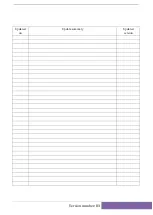
186 Parameters
Drive name
Shows the drive name. (The drive name can be set using the
DriveStudio PC tool.)
2
Drive type
Shows the drive type.
3
56.05
Signal2 mode
Defines the way the signal selected by parameter
is displayed on the optional control panel.
Disabled
Signal not displayed. Any other signals that are not disabled
are shown together with their respective signal name.
-1
Normal
Shows the signal as a numerical value followed by unit.
0
Bar
Shows the signal as a horizontal bar.
1
Drive name
Shows the drive name. (The drive name can be set using the
DriveStudio PC tool.)
2
Drive type
Shows the drive type.
3
56.06
Signal3 mode
Defines the way the signal selected by parameter
is displayed on the optional control panel.
Disabled
Signal not displayed. Any other signals that are not disabled
are shown together with their respective signal name.
-1
Normal
Shows the signal as a numerical value followed by unit.
0
Bar
Shows the signal as a horizontal bar.
1
Drive name
Shows the drive name. (The drive name can be set using the
DriveStudio PC tool.)
2
Drive type
Shows the drive type.
3
57
57 D2D
communication
Configuration of drive-to-drive communication. See also
section
on page
57.01
Link mode
Activates the drive-to-drive connection.
Disabled
Drive-to-drive connection disabled.
0
Follower
The drive is a follower on the drive-to-drive link.
1
Master
The drive is the master on the drive-to-drive link. Only one
drive can be the master at a time.
2
57.02
Comm loss func
Selects how the drive acts when an erroneous drive-to-drive
configuration or a communication break is detected.
No
Protection not active.
0
Alarm
The drive generates an alarm.
1
Fault
The drive trips on a fault.
2
57.03
Node address
Sets the node address for a follower drive. Each follower
must have a dedicated node address.
Note:
If the drive is set to be the master on the drive-to-drive
link, this parameter has no effect (the master is automatically
assigned node address 0).
1 … 62
Node address.
1 = 1
57.04
Follower mask 1
On the master drive, selects the followers to be polled. If no
response is received from a polled follower, the action
selected by parameter
is taken.
The least significant bit represents follower with node address
1, while the most significant bit represents follower 31. When
a bit is set to 1, the corresponding node address is polled. For
example, followers 1 and 2 are polled when this parameter is
set to the value of 0x3.
No.
Name/Value
Description
FbEq
Summary of Contents for ACS850 series
Page 1: ...ACS850 Firmware Manual ACS850 Standard Control Program...
Page 2: ......
Page 4: ......
Page 24: ...24 Start up...
Page 28: ...28 Control locations and operating modes...
Page 252: ...252 Fieldbus control...
















































